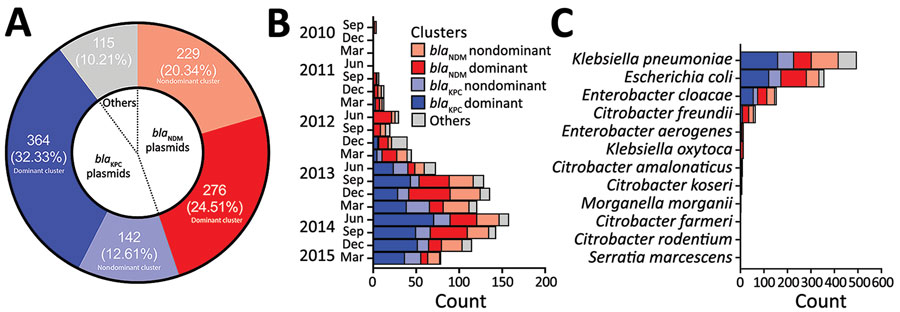Dominant Carbapenemase-Encoding Plasmids in Clinical Enterobacterales Isolates and Hypervirulent Klebsiella pneumoniae, Singapore
Melvin Yong, Yahua Chen, Guodong Oo, Kai Chirng Chang, Wilson H.W. Chu, Jeanette Teo, Indumathi Venkatachalam, Natascha May Thevasagayam, Prakki S. Rama Sridatta, Vanessa Koh, Andrés E. Marcoleta, Hanrong Chen, Niranjan Nagarajan, Marimuthu Kalisvar, Oon Tek Ng, and Yunn-Hwen Gan

Author affiliations: National University of Singapore, Singapore (M. Yong, Y. Chen, G. Oo, K.C. Chang, W.H.W. Chu, N. Nagarajan, M. Kalisvar, Y.-H. Gan); National University Hospital, Singapore (J. Teo); Singapore General Hospital, Singapore (I. Venkatachalam); National Centre for Infectious Diseases, Singapore (N.M. Thevasagayam, P.S.R. Sridatta, V. Koh, M. Kalisvar, O.T. Ng); Tan Tock Seng Hospital, Singapore (V. Koh, M. Kalisvar, O.T. Ng); Universidad de Chile, Santiago, Chile (A.E. Marcelota); Genome Institute of Singapore, Singapore (H. Chen, N. Nagarajan); Nanyang Technological University, Singapore (O.T. Ng)
Main Article
Figure 2

Figure 2. Percentage and distribution of dominant carbapenemase-encoding plasmids in clinical Enterobacterales isolates and hypervirulent Klebsiella pneumoniae, Singapore. A) Percentage distribution of the total carbapenemase-encoding plasmids identified. The blaKPC dominant cluster refers to those harboring pKPC2 plasmid; blaNDM dominant cluster refers to those harboring pNDM1 plasmid. Others indicate carbapenemase-encoding plasmids that do not carry blaKPC or blaNDM. B, C) Distribution of carbapenemase-encoding plasmids identified among Carbapenemase-Producing Enterobacteriaceae in Singapore (CaPES) (Enterobacteriaceae is the former name of Enterobacterales) samples collected during September 2010–March 2015 (B) and among Enterobacterales isolates (C). Nondominant cluster refers to other plasmids carrying blaKPC or blaNDM. We found that pKPC2 was the most dominant carbapenemase-encoding plasmid in Singapore during 2010–2015.
Main Article
Page created: June 22, 2022
Page updated: July 20, 2022
Page reviewed: July 20, 2022
The conclusions, findings, and opinions expressed by authors contributing to this journal do not necessarily reflect the official position of the U.S. Department of Health and Human Services, the Public Health Service, the Centers for Disease Control and Prevention, or the authors' affiliated institutions. Use of trade names is for identification only and does not imply endorsement by any of the groups named above.
